 |
Petersburg
|
 |
Petersburg
|
In the beginning, this land was inhabited by the Arapaho and
other tribes of Indians. They roamed freely, hunting and fishing
in the Platte River and the Bear Creek. Wild berries and plums
grew in abundance and, as the Indians roamed, they made use of
this great feast.
Then the White Man came. Gold was discovered near Little Dry Creek, [Around Dartmouth and Santa Fe Avenue]; a plaque identifies the site. The army surveyed the area in 1857. John McBroom was a member of this group as wagon master. He returned and filed a Homestead on a parcel of land.
Peter Magnus (Magnes) was born in Eksjo, Sweden, on March 12.
1824, and was very active in agriculture and farming1. For a period
of time he was also a blacksmith and veterinarian. When he was
twenty-six, he emigrated to the United States and followed this
trade in Dunkirk, New York, and near Chicago at Ottowa, IL. It
was in Ottowa that he met his first wife, Bertha, to whom he was
married in early 1859. Shortly after their marriage, the news
of the discovery of gold at Pikes Peak swept through that part
of the country, and with the itch for adventure, he set out with
a covered wagon train for the west, arriving in Denver on June
18, 1860.
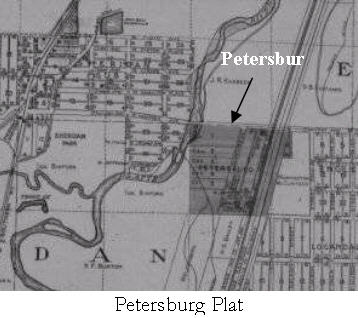 They were
delayed for several weeks by the birth of a baby girl they named
Lena. She was born in a covered wagon on the banks of Cherry Creek.
It is possible she was the first white child born in this area.
They were
delayed for several weeks by the birth of a baby girl they named
Lena. She was born in a covered wagon on the banks of Cherry Creek.
It is possible she was the first white child born in this area.
We do not have much information about Magnes during this time period. We can assume that he farmed and proved up the property as required by a Homesteader, although we can find no record of a homestead document for him. He had the Platte River for water and much experience behind him. Many settlers left the land to move to an urban area for the winters as they were severe and lonely.
In 1865 he began to plan what would become known as Petersburg,
the area's first substantial settlement2. He invited other Swedish
immigrants to join him and on September 13, 1873, the Petersburg
plat, County plat BA1 P2, was recorded at the county. Its boundaries
were west of (present) Natches Court (then Mill Road), South Santa
Fe Drive (then Main Street) on the east, Sheridan Avenue which
became (Old) Hampden Avenue on the north.
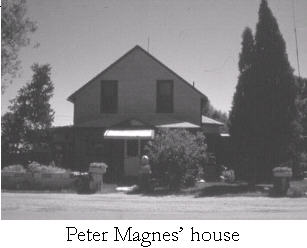 Juanita
and Robert Sitler, who lived in Peter Magnus' house, related that
they had to dig a basement, since the tree stumps the house had
been built on had finally rotted after one hundred years. In the
digging, many Indian artifacts were found, which Mrs. Sitler kept.
After Mr. Sitler passed away, Juanita sold the house and moved
from the city. We do not know what happened to the artifacts and
papers they had.
Juanita
and Robert Sitler, who lived in Peter Magnus' house, related that
they had to dig a basement, since the tree stumps the house had
been built on had finally rotted after one hundred years. In the
digging, many Indian artifacts were found, which Mrs. Sitler kept.
After Mr. Sitler passed away, Juanita sold the house and moved
from the city. We do not know what happened to the artifacts and
papers they had.
Petersburg was part of the Louisiana Purchase and became the Kansas Territory, but in 1861 President James Buchanan signed legislation creating a new territory [The Colorado Gambler, July 22-28, 2008] that many wanted to call Jefferson (in honor of the President who made the Louisiana Purchase possible), but the name Colorado was selected. On August 1, 1876, it became a State.
December 7, 1859, saw the advent of a toll road, authorized
by the General Assembly of Jefferson Territory, which also established
toll fees "for each wagon, two horses, mules or oxen, twenty-five
cents; every horse, with or without rider, ten cents; for every
head of cattle, five cents; footman free."
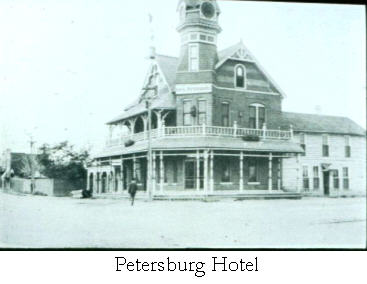 Developed
by Denver, Auraria, and South Park Wagon Road Company and called
the Bradford Toll Road, it ran from Denver-Auraria along the east
side of the Platte across Brown's Bridge over the Platte at about
present-day Union Avenue, through the town of Bradford (Ken-Caryl
Ranch area) to South Park to the Arkansas Mines. It became the
route of one of the earliest stage coach routes to South Park.
Petersburg became a stopping place for wagons because it was perfectly
situated just off the Bradford toll road. In 1879 the Petersburg
Hotel was built near the corner of what is now Hampden and Santa
Fe. The hotel served as a focal point of community activity, which
also boasting eight blacksmiths, fourteen saloons, one newspaper
and three stores in the immediate vicinity.
Developed
by Denver, Auraria, and South Park Wagon Road Company and called
the Bradford Toll Road, it ran from Denver-Auraria along the east
side of the Platte across Brown's Bridge over the Platte at about
present-day Union Avenue, through the town of Bradford (Ken-Caryl
Ranch area) to South Park to the Arkansas Mines. It became the
route of one of the earliest stage coach routes to South Park.
Petersburg became a stopping place for wagons because it was perfectly
situated just off the Bradford toll road. In 1879 the Petersburg
Hotel was built near the corner of what is now Hampden and Santa
Fe. The hotel served as a focal point of community activity, which
also boasting eight blacksmiths, fourteen saloons, one newspaper
and three stores in the immediate vicinity.
As wagon trains came along, Petersburg became a popular stopping off place, because when Denver acquired the first railroad, they no longer allowed the freight wagons to enter the city. At the corner of Hampden and Santa Fe Drive (Main Street), a large corral was built behind the hotel which was known as the Petersburg House. Here the wagon trains would unload and the teamsters spend several days blowing their hard-earned cash on wild women and whiskey.
In 1874, Peter Magnus erected the Harvest Queen Grist Mill [also called the Harvest Queen Flour Mill]. This enterprise proved to be a financial failure and he soon abandoned it. The building burned in 1883. The area later became a fish hatchery.
Magnus understood that cultivation in this semi-arid land would
be different from the more lush, fertile areas of the Midwest,
and together with Joseph M. Brown and Samuel W. Brown, donated
land and organized the Petersburg Ditch Company, November 30,
1861 (The Roots of Prosperity: Littleton in the 1860's by Laurence
W. Steele). This ditch turned the wheel for the grist mill in
Petersburg. The ditch was leased to Henry Alshouse on or about
May 6, 1874.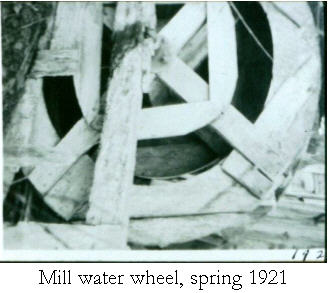
During 1888 Bertha Magnus conveyed the rights of way, right, title and interest in the Petersburg ditch which ran across her land to the Town of South Denver. She did, however, reserve the right to irrigate all of her land from it.
According to a newspaper article in the Denver Republican, April 28, 1889, South Denver water works attempted to condemn the use of the Old Petersburg Ditch. The town filed suit in District Court, stating that they had purchased fifteen acres of ground in the Petersburg area, Lot 6, Block 1, upon which to locate its wells and storage of water. "Upon this lot was formerly a flour mill, owned by Clark and Failing, operated for many years by a water power furnished for and through what is known as the Petersburg ditch, which was used for irrigating land as well as for supplying water for the mill." It would be necessary to enlarge this ditch at its head and necessary for the town of South Denver to have a strip of land fifty feet wide, going twenty-five feet on each side of the center line of the ditch throughout its entire length.
The Town said their action would not violate the rights of the then property owners, Anna Brown and Joseph Brown. However, a just compensation could not be agreed upon. After a three day trial, the jury ruled for the Town of South Denver, but granted Joseph Brown $2,000 damages, $662 for land taken away, and $150 for benefits. For Anna Brown, the award was $2,000 damages, $591 for land taken away, and $150 for benefits. The cost was a total of $5,443 (a large settlement for that day) for four acres they claimed was not worth $200 an acre.
An extract from affidavit of W. P. Miller, a resident of University Park since 1890, said that University Park was in the corporate limits of the Town of South Denver, until it was annexed into the City of Denver in 1894, and that he was a Trustee of University Park. He also said that the water brought from the Petersburg Ditch was poor quality, and not of enough quantity to be of value.
On January 9, 1923, Fenner F. Burton filed suit in Arapahoe District Court, case No. 1603, claiming to own the land under the Petersburg Ditch, that some of the water rights had been conveyed to the Town of South Denver, and that said Town did maintain and operate the ditch and supply water to the grantors (Browns, and Mrs. Magnus) and did use the ditch to flow water for the use and benefit of the Town of South Denver, but after the Town of South Denver became a part of the City and County of Denver, and it operated and maintained the ditch until 1912 when it denied any liability, and thereafter refused to care for the property. The City and County of Denver conveyed to Arthur W. Welfenberg the land and asked that the water rights be returned. The court then found that the rights were to be divided among the seven claimants. Englewood Water Department is now the owner of these water rights.
Peter encouraged the emigration of Swedish folks and became known as the "King of the Swedes." He helped organized the Swedenborgian church, which was located near Denver on the west side of Cherry Creek. He paid the preacher's salary and paid to print one thousand of copies of Swedish books for distribution in the area. He acquired the Denver Weekly Blade, a Swedish newspaper founded in 1888. Peter moved it to 19th and Larimer Street, and changed the name to the Swedish Correspondent. Every year large Swedish gatherings would be held on his ranch, with an abundance of food and fun for all.
He bought ground for the jailhouse, where the Criminal Court now stands [in Littleton]. He organized the first stock growers association and recorded the first brand in their books. In this book, he made the following notation: "He who steals the cattle increase of your herd is no better than he who steals your pocket book." Sometimes the Indians would steal his cattle and in a few days would come and tell him that they had found the stock, expecting a reward, which Magnus always paid to keep the peace.
At one time [it was claimed] he had accounts in every bank in Denver and word was that he held mortgages on everything in Petersburg and Littleton. There is no doubt that he was a frugal, yet generous man.
While he gave Petersburg the plot for the Community church and for the school, on one occasion he became angry at the sheriff because he charged him ten cents too much for serving him a paper at the courthouse and sued the county to collect the dime.
The Petersburg Mission did not fare well. It was formed in 1902 and in its decline at the Petersburg location served less than 20 members. Sometime after 1915 the church merged its records with another and the property was listed for sale in 1927.
On another occasion he had a dispute with two of the members of the Board of Commissioners while he was Chairman, and brought them into court, spending his own money for court costs and lawyers. There he proved what he believed to be an illegal measure, and won his case. Rumor says that when John McBroom's house burned, Magnes rode up, dug into his pocket, pulled out a handful of cash and gave it to John.
Sometime after a major flood, Peter Magnus purchased Joseph Skerritt's property, which was south of Petersburg. Joseph Skerritt then moved to Orchard Place [Englewood] and farmed. He is known as the father of Englewood.
In 1887 Lt. General Philip A. Sheridan selected the land for a military post. Folks referred to the post as "The Fort" or "Fort Sheridan", although the fort had not been named. On April 5, 1889, a fort near Chicago was named for General Sheridan and "The Fort" was named Fort Logan for General John A. Logan, who later became a member of the United States Congress, and is credited with the creation of "Decoration Day" which has been observed since May 30, 1868. Today it is commonly known as "Memorial Day."
The military quickly cut a road from the railroad which cut through Petersburg, North to South, it was named Sheridan Avenue [now called Hampden Avenue and in some places US 285].
The court approved incorporation of the town on April 14, 1890, and Sheridan was born. This area was thought to include Petersburg on the east and Logantown on the west. Peter Magnus [on the original petition his name was signed Peter Magnes and a Charles Magnes also signed] objected as he thought the town would be named Petersburg, and land owners south of Oxford, the Browns, also signed and then objected to it. Jacob Puff was elected the first Mayor.
Soon after the Petersburg School fire, the need for an established firehouse was recognized, one was built in 1936 and added onto in 1949. The City Hall occupied a residence next door and was later connected with a covered walkway. The original firehouse was torn down in 1959 and a new two-story firehouse was built almost entirely by volunteers.
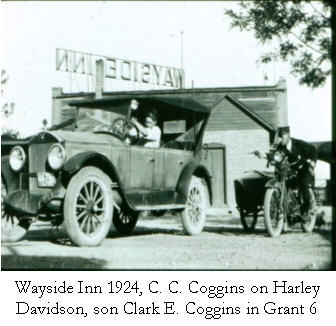 The Wayside Inn,
about four buildings south of the Petersburg Hotel had a reputation
for vice. It is believed that it may have been erected in the
later part of the 1880s, and was considered on of the wildest
spots of old Petersburg. The building was a two story structure
with stables in the rear, to house the horses of the weary travelers.
It had a huge kitchen with a brick bake-oven built into the wall.
In the front part of the building was a large dance hall and barroom.
Between the stable and the inn there stood an old cell house with
windows on the north and south covered with bars. In the floor
was a trapdoor which led to a small brick cellar underneath. There
are many legends surrounding this cell house and cellar, and some
say it way only to keep their wines and vegetables; yet others
say it also played a twofold purpose, for when the customers became
too drunk and rowdy the bouncer would place them in the cell and
leave them there until they sobered up enough to go on their way.
It also made a convenient hiding place for some of the naughty
ladies who operated in this establishment, especially if the Marshal
was paying a visit.
The Wayside Inn,
about four buildings south of the Petersburg Hotel had a reputation
for vice. It is believed that it may have been erected in the
later part of the 1880s, and was considered on of the wildest
spots of old Petersburg. The building was a two story structure
with stables in the rear, to house the horses of the weary travelers.
It had a huge kitchen with a brick bake-oven built into the wall.
In the front part of the building was a large dance hall and barroom.
Between the stable and the inn there stood an old cell house with
windows on the north and south covered with bars. In the floor
was a trapdoor which led to a small brick cellar underneath. There
are many legends surrounding this cell house and cellar, and some
say it way only to keep their wines and vegetables; yet others
say it also played a twofold purpose, for when the customers became
too drunk and rowdy the bouncer would place them in the cell and
leave them there until they sobered up enough to go on their way.
It also made a convenient hiding place for some of the naughty
ladies who operated in this establishment, especially if the Marshal
was paying a visit.
In the 1920s, the James W. Gomer family occupied the Wayside Inn as a dwelling, and their daughter [Juanita], Mrs. Robert Sitler, recalls quite clearly the old dungeon which which the kids used as a playhouse, and the stables which were still standing at that time.
Near the turn of the century, this building was owned by a man named De Mandel. He built the home which is now occupied by Leslie Paull on Natches Court [early 1900s]. In those days gambling was a big sport at the inn and, as law enforcement officers began to crack down, De Mandel sought a safer shelter for his important customers. He constructed an addition on the northeast corner of his home on Natches Court. This addition was fourteen by twenty-eight feet, and the floor was laid right on the ground.
Here he organized the Gilt-Edged Club, made up of wealthy gamblers, where they could carry out their game away from the inquisitive eyes of the general public. There is an old legend that he dug a tunnel from the house to the river to make escape possible the of these men should the place be raided. One of the two steps leading from the main section of the De Mandel house to the gambling room had hidden hinges under it and under the step is ample space to hide cards and plenty of gold. Many of the old timers say they saw more gold in that room than in any other place in the State of Colorado.
Mrs. Barbara Mitoff, daughter of Lowell Banes, recalled living in the inn as a child. It boasted a drop wall where the gambling equipment and wealthy patrons could hide and find access to a pair of tunnels which led west to Platte River. The existence of these tunnels had been known by local residents for several years, but until 1959 when the Highway Department bought pieces of real estate and began construction to widen and reroute Hampden Ave. (U.S. 285), its exact whereabouts remained unknown by most.
One river entrance was in the basement of Leslie F. Paull at 3520 So. Natches Ct. Englewood Herald reporters and Mr. Paull investigated the site after the demolition of the home. They found a large hole near one corner of the foundation. Upon some digging they unearthed two coins, one from 1855, the other from 1845 [coins are early since Peter did not arrive until 1859 or 1860] .Another tunnel opening had been found some years before near the Platte and had been boarded up for safety reasons. The second entrance was found when preparing the land to be filled. The supervisor on the job, came into City Hall and announced that they had just found the tunnel in their excavations.
The Petersburg Hotel was built in 1889 by Pat [called Pap by some historians]. It was known throughout the West as a famous Showplace, and could be seen for miles. In the lithograph it shows bicycles, and horse drawn carriages that it was a popular gathering place for the Denver pleasure seekers. This group of bicycles was part of the group known as the Denver Bicycle Club, which spent weekends riding throughout the territory adjoining Denver. Many of the Denver residents came out as far as the 3500 block on South Broadway by streetcar and walked through a shady lane running parallel with present Hampden Avenue [then called Sheridan Ave], for three-quarters of a mile to reach the hotel.
The area was first known as a farm center, although its new reputation would center on The Wayside Inn, The Petersburg Hotel, and other roadhouses in the area [Ghosts of the Colorado Plains, by Perry Ererhart]. In the early 1900s ladies were available for a price and entertainment consisted of gambling and prize fights. Soldiers from the Fort and bar patrons were involved in brawls. From 1908-1910 it was closed often, for gambling, prostitution, and breaking other laws.
In 1909 four masked gunmen invaded a fancy dinner party of wealthy Denverites and robbed the patrons of jewels and money valued at $4,000.00, although they missed an additional $8,000.00 in cash and jewels. In 1916 after complaints from local citizens and ministers, J. W. McBroom who was sheriff of Arapahoe County, and his brother-in-law, Deputy Fred Curkeet, decided to take action. They visited the leading churches in Littleton and Englewood, McBroom deputized a raiding party. Moving down to the partially fenced "City of Sin," the big raid went into action. Over a hundred prostitutes were hauled out of bedrooms, clothes closets, and off the roof. Amidst the excitement one prostitute dropped a jug of whiskey on one of Arapahoe County's leading citizens. What he dreamed of for the next fifteen minutes no one will ever know, but with the smell on his clothes, he must have had a lot of explaining to do to his wife.
Among those rounded up was the famous "Red Steer." who was well-known through the West as a leading Madam. The girls were taken to the Littleton jail, where they were turned loose in the corridors once the cells were full. To the relief of all, this ended "Sin Town" on Santa Fe. In 1939 the buildings were razed to widen Sheridan Avenue [now Hampden Avenue].
One of the most colorful figures in the early life of Petersburg was Judge Edward Bean, known as the "Marrying Justice." who served Petersburg and the Littleton area as Justice of the Peace for over sixteen terms. He was born in Maine in 1836, and went with his parents to Louisiana. When the War of the Rebellion broke out, he joined the Yankees until the defeat of Lee at Appomattox. He then joined the Carpet Baggers and went back to Louisiana, where he was appointed Election Supervisor.
He then went to Chicago to be with a brother who married a girl named Rebecca, who was a northern sympathizer, and had escaped from Virginia by night, burying the family heirlooms, and taking only the clothes on their backs. After the marriage, they came west to seek a future in this pioneer country and settled at Petersburg.
Edward Bean joined his brother soon after and became quite active in politics in this early pioneer community. He not only served for 38 years as Justice of the Peace, but also started the first post office in this area. In those days the post office was located at about 3573 South Santa Fe Drive, and was an important community center as there were no street deliveries and everyone had to come and get their mail. Across the road from the Post Office the judge would stand to hand the mail sacks to the baggageman on the trains as they passed by. The local mail was thrown out at the same time.
The judge, with his long beard, was a popular person at all social and political gatherings. He always said the way to keep young was to stay in the fight. He was feared by criminals and loved by the law abiding citizens. One of his favorite sayings was "Crime doesn't pay."
When his brother died, he married the widow, who was 15 years older than himself. Rebecca lived to be 102, and at her funeral in 1924, the crowd was so great that many people stood in the yard. The records show that sometime in his early life Judge Bean was married before, but to whom and where we do not know.
Judge Bean died as colorfully as he lived and if there was much mystery in his life, there was even greater mystery in his death. Around midnight on Tuesday, August 21, 1928, as the story goes, two persons, one a man and the other now believed to be a man in woman's clothing, rapped on the door of the judge's residence at 3575 South Santa Fe Drive.
The judge, who was accustomed to having persons call at all hours of the night to be married, opened the door unhesitatingly. The lady housekeeper, also hearing the knock, testified that the couple entered on the pretense of getting married, and as the ninety-two year-old judge sat down to his desk to reach for the application blanks, one of the men thrust a gun in the side of the housekeeper and the other thug dashed over to the desk and struck the judge on the side of the head, as he was reaching for a gun.
He was beaten with the butt of a revolver, his wallet was robed of $60.00, and he was left to die. The two criminals fled. When help arrived, they found one side of Judge Bean's head badly bruised and a large cut on his neck. They decided not to remove him to a hospital, but with his fighting spirit he lingered on until 3:30 a.m. August 29, the following week. Harry Hively was at his bedside the night before he died.
The Judge's final resting place is in Littleton Cemetery, among his friends and early pioneers of Arapahoe County. To this day his murder is still unsolved.
Petersburg School was built in 1892 on land donated by Peter Magnus. A fine brick building was used by many of the children in the district until March of 1927, when it burned to the ground. Children went to school in various homes until a new school could be erected. The three school board members were Leslie Paull, Harry Hively, and Mrs. Fred Gaspard.
"Amidst swirling clouds of black smoke whirling about their little bodies, and flames shooting high from the crackling roof, 80 children of the Petersburg grade school on March 10, 1927, made their way to safety." The children ranged in age from six to fourteen, and through their calmness and the heroic action of a teacher, not one life was lost, ever though the building was demolished. The blaze was discovered by David Crane and Chub Skinner, two young men from Littleton who were driving north on Santa Fe enroute to Denver.
The young men hastened into the school house and notified Mrs. Edna Post, the school Principal, who was teaching the seventh and eighth grade class at that hour. The teacher calmly told the students to form in line and take their coats as they were going out for a fire drill. Second floor students used the funnel-shaped fire escape to safety and the lower level marched out under the direction of the teachers Mrs. Frances Miller and Miss Belle Morris.
The young men notified the all the fire departments in the area and the response came from the Petersburg Volunteer Hose Company, the Littleton and Englewood Fire Departments, Engine Company 19 from South Denver [which was not in the city of Denver yet], the General Iron Works fire department and the Alexander Film company departments.
With the roof in flames and whole building about to go up, there was no fire wagon yet in sight. The teachers, along with the men passing by, organized crews and entered the flaming building to remove the new piano and as many desks and books and other furniture as could be easily taken.
A little girl, Mildred Flueckiger, became panicked over the fact that she had left her hat inside, and childlike, after the students and men had given up the rescue work because the fire had become too intense, dashed into the flaming building. Mrs. Miller ran in after her, and in the rescue was burned about the neck by flaming cinders.
The General Iron Works fire department was the first to arrive at the scene, but no water was available. When the Englewood fre department arrived they had water tanks and were able to get a line on the fire. The Petersburg Volunteers plunged through the brush and snow to a well, which was located by the hatchery, a block away from the school. The Littleton department ran their hose to the Platte River, a quarter of a mile away. The Denver department used their chemical tanks. Everyone in sight was mustered into duty, and the children were given the task of carrying what had been rescued from the school to the fish hatchery where it could be stored. This was carried out under the direction of Mrs. Frank Nesbit, wife of the Treasurer of the Board, and Jennie Gaspard, President of the Board. Don Weist, the Board Secretary helped direct the fire-fighting equipment at the Platte River.
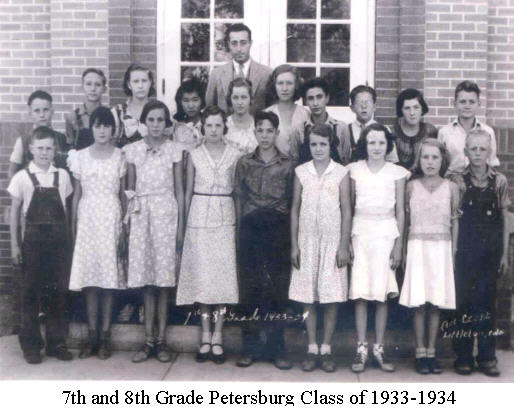

But the battle was in vain, and, in those days of limited fire-fighting equipment and without quantities of water, the building was doomed. To the present [1927] this was Sheridan's greatest fire, although the town folks could rejoice that no lives were lost, and immediately went to work to prepare housing so that the school program would not be interrupted, and to erect a new school building; which rose out of the ashes of the old, and, we might well say, stands as a memorial to teachers who kept their heads in an hour of crisis, and saved a community from what might have been a tragic catastrophe."
Sheridan School District has a history that tells the story of how a community grows and consolidates. Its history begins in Petersburg, "just prior to the Civil War with a log cabin situated east of the Platte River where a toll bridge was built [north of present-day U.S. 285, and west of present-day Santa Fe Avenue] (A Historical Sketch of Petersburg School, District 23, document found in Petersburg School cornerstone)."
Clark Bond recalls, "About 1893 a brick building was erected on land deeded to the district for one dollar by Peter Magnus. In 1909 District 22 was set aside and became District 23. Mr. Hoskins, Joe Brown and Tom Skerritt were the first school board. Among the first students were Sherman and Clarence Brown, Joe, George, Charles, and Mamie Skerritt. Some of the early teachers were Minnie Mae Bell and S. Ella Brown. From the log cabin, the school moved to a frame building (where the Englewood Depot stands today) [the Englewood Station has been moved]."
The school had two teachers, Mrs. Francis Miller and Miss Belle Morris. It burned to the ground in the spring of 1926 (Littleton Independent, front page, March 29,1940) and the cornerstone of the new building was laid in October of 1927 (A Historical Sketch of Petersburg School, District 23).
Petersburg School District serviced "the residences that were along what was Natchez Court [and South Santa Fe Avenue]. At that time, Natchez Court came straight off Hampden and went straight south to where it curved into Kenyon, south of the Petersburg school, east to the railroad tracks, little bit further north of Hampden, a little bit south of the area adjacent to Kenyon," said Clark, a 32-year veteran of the Sheridan District and alumnus of Petersburg and Sheridan Union High School. He adds, "The Petersburg school district also encompassed much of that area down on the other side of the Platte in lower Sheridan."
Reminiscing about his school days, Bond remembers that Petersburg only went through the eighth grade and that for "a period of time when students finished up at Petersburg, they [Petersburg school board] were constantly trying to work out an arrangement for somebody to take the students after they got out of Petersburg. There was an agreement between Petersburg and Englewood for a long period of time...and then around the late 1940s Englewood discontinued for whatever reason and would not take Petersburg students after that. For a period of time there was another arrangement those students went to South High School in Denver. Then I guess it became apparent that that arrangement was not going to last. In fact, I think some may have gone to West High School. It was kind of jumbled relationship, and I think at one time high school kids were being parceled out to whomever would take them.
"In the late forties, early fifties, they began to feel that would not be a permanent solution because when I went to Petersburg in fifty, when we continued through the seventh grade, they had no place for us to go, so they added the eighth grade. When I got out of the eighth grade, they still did not have a place so they added the ninth grade. When I got out of the ninth grade, they still did not have a place, so they added the tenth. When I got out of the tenth grade I don't know where I would have gone, but they had completed the Union High School over here. That was the fall of fifty-two, so I was able to come over here.
"That got to be kind of interesting for a period of time, 'Where do we go next?' I could see myself graduating from Petersburg, going through the twelfth grade because they didn't have any place for us to go." Jim Taylor, a 35-year veteran of the district, mentioned that many of these students also went to Littleton High School, in addition to those attending West and South High Schools.
In 1974, they closed Petersburg Elementary school. The reason, says Taylor, is that there were, "terrible conditions for the kids to learn over there, with the trains going by every hour and the traffic sounds." School officials retrieved the materials from the cornerstone and have them on display at the administration offices at Ora Oliver. A decrease in student population due to the loss of residences in the 1965 flood contributed to the decision.
Peter Magnes was also active in local politics, nominated on both the Democratic and Republican tickets for County Commissioner in 1886, serving unti1 1889, when he was re-elected for another four year term. He died suddenly of apoplexy on Apri1 14, 1902, during a meeting of Petersburg Lateral Ditch Company one year, almost to the day, before the pitched battle for the county seat began between Petersburg and Littleton.
In 1903 Petersburg was being considered as the Arapahoe County seat in hot competition with Littleton, but Littleton won. The area grew rapidly after those first hard years.
Technology pushed its way west. The railroad played a major role in opening the great frontier to easier exploration, exploitation and settlement. The Denver & Rio Grande narrow gauge from Denver to Colorado Springs was completed on October 21, 1871. It was the fifth railroad completed in Colorado and ran along the west side of the Platte River.
The Atcheson, Topeka and Santa Fe Railroad built north to Denver, May 1882. Main Street in Petersburg then became Santa Fe Drive, named for the railroad. A third standard rail was laid by Denver & Rio Grande along the Atcheson, Topeka and Santa Fe lines. The rail lines bisected Petersburg, and left some of the subdivision lots on the east of the line.
Except for the tracks along Santa Fe Drive, major transportation route for freight trains, most of the railroad tracks and their attendant stations have been abandoned and are gone. Renovation is in the works for the Englewood station, however, which was built in Sheridan's city limits, situated on the east side of the tracks, just south of U.S. 285. Through a cooperative agreement the Station has been moved to the Corner of West Dartmouth Avenue and South Galapago Street.
Sheridan boasts major transportation routes; U.S. 285, known as Hampden Ave.; State Highway 85 or Santa Fe Drive, and Highway 88 or Federal Blvd. All of these roads provide major accesses from the Denver metro area, in all directions and is still an important juncture for travel and commerce.
For a stroll down the commercial history of our community, please refer to the Sheridan Celebrates "The Pumpkin Festival" September 27, 1997, program book. It excerpts listings from the "Colorado State Business Directory," published for areas with a post office. You can let your fingers do the walking though time through listings that include important and interesting historical information, and offer a unique insight into the importance placed on names as evidenced by the multiple spellings of people's surnames and their occupations, and their locations in the area. Both Petersburg and Fort Logan were listed, but no listing was found for Sheridan, even after 1900, since Sheridan never had a post office, which meant that all the mail, goods and services flowed through the post office in Petersburg or Fort Logan.
By 1900 the area was connected by electric street car line. In 1901 the population had dropped to three hundred. In 1914 the population rose again to five hundred. In 1915 they apparently re-measured the distance from Denver, and came up with eight miles. In 1920 the nearest bank was Englewood. In 1923 the altitude was listed as five thousand feet, and the post office was three miles northwest of Littleton, the county seat. 1924 showed an increase in population to six hundred and by 1927 it had risen to seven hundred.
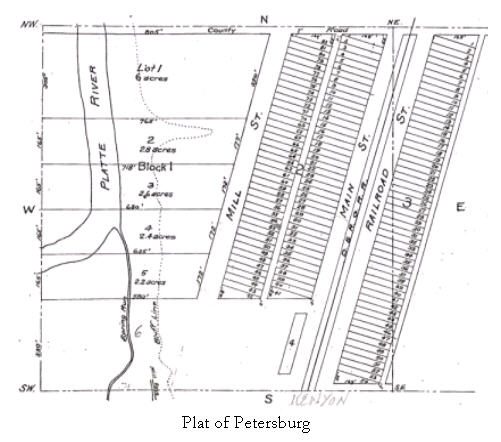
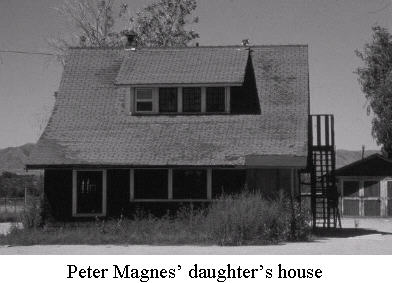 Mr.
Bond who moved to the Petersburg area in the early 1930s, recalls
much about the area and the residents. Approximately one-half
block N of the Petersburg Hotel, was a way station for the stagecoach.
The building then became a brothel and later the Cody Inn, operated
by the Christiansens. That was in the middle to late forties.
Mr.
Bond who moved to the Petersburg area in the early 1930s, recalls
much about the area and the residents. Approximately one-half
block N of the Petersburg Hotel, was a way station for the stagecoach.
The building then became a brothel and later the Cody Inn, operated
by the Christiansens. That was in the middle to late forties.
On the corner of Santa Fe there was a filling station/convenience store run by the Springers, they lived in a two story house in the area of the triangle to Natches.
Block 2 facing Mill Street was the Colburg's filling station, with the house behind, with two or three cabins. South of that lived the Quinns. Lots 55-59 was Leslie Paull's. He was a Spanish American War Veteran and served on the Petersburg School District Board in the 1920s, and was known for the famous tunnel.
South of that was Mrs. Anderson, the Potters, Nona Ferris, and, south of her, the Brouse family, Marjorie, the daughter, who later married a Page and became the Clerk and Recorder for Arapahoe County. This property later sold to Arell Miller.
The Magnes house where Bob and Juanita Sitler lived, then the Eastmans, and the Huddlestons. The Congregational Church sat on the alley of lot 42. All of these faced Mill Street, or Natches Court.
The hotel [Petersburg] was near the corner of Santa Fe and Sheridan Ave (Hampden) as part of the way station. The Wayside Inn was South of that but gone by the 1940s. Harold Gomer and wife Agnes bought the property.
Block 1 lot 1 with 6 acres was the Grindengers; they lived behind the chicken houses and open fields, while the Nelsons lived in part of the chicken houses. Clark Bond [grandfather] had the frontage of 200-250 feet. Ergle owned part of lot 2; lot 3 was Maurice Nesbitt, which earlier had been Peter Magnes' daughter's house. Between lots 3 and 4 was a dirt road which ran from Mill Street to the river, where Hall Sand and Gravel operated. Lots 4-5 were owned by Mr Openlander who had a big white house. Word was that he received money for every truck that used the dirt road [to haul gravel].
The blank area is where Petersburg School was. South of Kenyon at Main and Kenyon, the Holders lived (in the SW corner), and owned property to the bluff line. Natches Ct. continued south as a dirt road to the fish hatchery, owned by a family named Cherisico (sp), who grew watermelons among other things. There was a feed store at the tracks and Kenyon, but Clark does not recall any houses on the east side of Santa Fe Dr. Nor does he remember a post office. He thought everyone went to Englewood to get their mail.
Clark's grandfather died in 1947, but had lived there with his wife Elsie for fifteen to twenty years prior to 1938. He owned and ran a newspaper the West Side Hustler in the 1900s to the late 1930s. The Bond's also owned property on Mansfield near Lowell, Grandmother Elsie, was the proprietor of the store there for some time. Young Clark's father was a printer.
In 1959 the Highway Department moved the Bonds and others out. They were once again widening the old Sheridan Avenue. It had become Hampden Avenue, and then it was 70 and widened; following Hampden in most places, but leaving little stretches of Hampden here and there. It then became U. S. 285 and was widened again. This took a great portion from the north of Petersburg. Santa Fe Dr. was also widened as well as the railroad tracks, taking more off the east side. So Petersburg was being decreased in size.
The City of Sheridan formed the Sheridan Redevelopment Agency after the Sheridan City Council requested a blight study on a portion of the City over two former landfill sites in early 2003. The blight study, done by Urban Plan, Inc., was completed June 30, 2003.
In accordance with §31-25-104 C. R. S. of the Urban Renewal Law, a public hearing was held, presenting evidence that was revealed by the blight study.
It revealed many problems, including deteriorated or deteriorating structures, inadequate street layout, unsanitary or unsafe conditions, conditions that would endanger life or property by fire or other conditions, and environmental contamination in the form of methane gas. Many photographs were included showing these and other problems.
Resolution No 49, 2003, was passed November 12, 2003, which states that a petition with the required number of signatures of registered electors within the City had been filed with the City Clerk declaring that there is a need for an urban renewal authority to function in the City. It titles the urban renewal authority as the Sheridan Redevelopment Agency.
The City of Sheridan hired Miller Weingarten Realty to developer the land. Miller Weingarten Realty negotiated with the property owners and the majority of land acquisitions. The Sheridan Redevelopment Authority authorized the use of eminent domain for the remaining few property acquisitions. The site was named by the developer as River Point at Sheridan.
The redevelopment area is approximately one hundred thirty-five acres bordering South Santa Fe Dr (US Hwy 85) and West Hampden Ave (US 285). Along Hampden and north of Bear Creek it extends west to Brady Court. In addition the project is enhanced by the South Platte River and Bear Creek trail systems.
A complete design of the property was performed, including building site layout, roads, and street designs. The first step was to remove the structures and businesses that were in the area. Many problems were discovered. Some barrels that had been stored, contained hazardous material, and needed to be demolished on site.
It was a sad occasion when Petersburg School was demolished. While the building had been sold by the school district a few years ago, and modifications had been made by the new owners, those present mourned the loss of a long time landmark and an old friend.
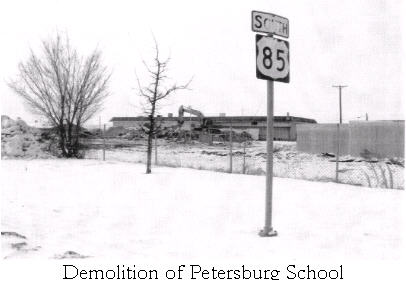 Once
all the debris had been removed, the developers went to work on
the landfill. At least five feet of landfill was removed from
the entire site and the landfill areas were properly capped for
the first time with geo-clean tech fabric, and dirt. A vapor venting
system below the surface for the methane gas was installed. In
some cases more landfill was removed for buildings, road, utilities,
and storm water management systems. Large trucks carried away
the old material and brought back clean fill dirt. They worked
around the clock, seven days a week. It took well over a year
to complete this work.
Once
all the debris had been removed, the developers went to work on
the landfill. At least five feet of landfill was removed from
the entire site and the landfill areas were properly capped for
the first time with geo-clean tech fabric, and dirt. A vapor venting
system below the surface for the methane gas was installed. In
some cases more landfill was removed for buildings, road, utilities,
and storm water management systems. Large trucks carried away
the old material and brought back clean fill dirt. They worked
around the clock, seven days a week. It took well over a year
to complete this work.
Meanwhile businesses signed letters of intent to use some of
the sites. It was beginning to take shape. At first only a few
stores signed, but then more were added as buildings began to
rise and streets, street signs, and signals were installed. A
new bridge over the Platte River was also built.
 Super Target
opened in July 2008 followed by Chili's and Costco in August.
Circuit City, Panera Bread, Great Clips, T-Mobile, Subway, Fat
Burger, Massage Envy, Pacific Dental, Game Stop, Snappy Nails,
and Carl's Junior will open in the fall. In the winter Chick-fil-A
will join them, and in late spring Regal Cinema will open. More
will come as time goes on.
Super Target
opened in July 2008 followed by Chili's and Costco in August.
Circuit City, Panera Bread, Great Clips, T-Mobile, Subway, Fat
Burger, Massage Envy, Pacific Dental, Game Stop, Snappy Nails,
and Carl's Junior will open in the fall. In the winter Chick-fil-A
will join them, and in late spring Regal Cinema will open. More
will come as time goes on.
All vendors will charge a one percent Public Improvement Fee (PIF. This fee, collected on all sales of merchandise and all services in the same manner as a sales tax, but it is privately collected and provided for funding the environmental remediation and building the public infrastructure. In addition one-half of the PIF is available to the City to provide public safety, street maintenance, and administrative services to the redevelopment area. Public infrastructure within River Point at Sheridan includes public street lighting, public roads and bridge; Water quality and protection; open space and trails, environmental remediation, utility infrastructure, and water quality and storm water systems.
Peter Magnes, as one of the area's first forward-thinking entrepreneurs, would have approved of this gem in Sheridan's crown.
Copyright © 2009 by the Sheridan Historical Society, Inc.
All rights reserved